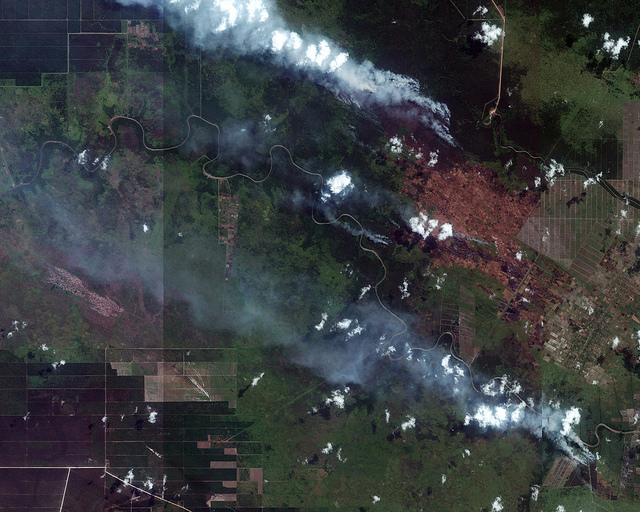Like this article? rabble is reader-supported journalism. Chip in to keep stories like these coming.
As the countries are preparing to meet at Paris climate conference to discuss new commitments on curbing carbon emission, a large area of forest land has been burning in South Asia since August, releasing as much daily emission of carbon dioxide and other greenhouse gases as the entire U.S. economy.
So why is almost nobody talking about this disastrous event? In the light of upcoming conference, how ridiculous is it that most of us are unaware about a catastrophic impact of what the experts have called the “the biggest man-made environmental disaster of the 21st century?”
If you search for “Indonesian forest fires” online, the results are hardly satisfying. Considering the impact that the fires have on the world’s levels of greenhouse gas emission and their overall social and health consequences, Western news media could have done a better job in letting the world know about the real scale of this environmental disaster. (Credit should be given to The Guardian for consistently following the event and providing more in-depth analysis on the issue).
Since summer, the plumes of suffocating smoke and haze have blanketed the whole neighbouring area, including Malaysia, Singapore and Thailand. In some cities the visibility was reduced to 30 metres, causing schools to be closed and flights cancelled. The smoke from the fires, which have forced people to wear face masks, led to more than 500,000 cases of haze-related respiratory diseases and resulted in the deaths of at least 19 Indonesians.
Indonesia’s diverse ecosystem, including animals such as orangutans, clouded leopards, the Sumatran rhinoceros and Sumatran tiger, is also under serious threat. Just in a matter of six weeks, Indonesia has moved up to be the world’s fourth largest CO2 emitter.
This year’s forest fires were called a “crime against humanity” by Sutopo Puro Nugroho from the Meteorology, Climatology and Geophysics Agency (BMKG).
What makes Indonesian fires an especially serious issue is their “man-made” aspect. Despite severe consequences to the public health and the environment, the forests are annually burnt using “slash and burn” strategy by logging companies and palm oil and pulp plantation owners, who find this practice of clearing the land less costly.
So far no adequate measures have been taken by government officials to stop these practices. Yes, the government has deployed 30 aircrafts and 22,000 troops to fight the fire. But what is the point of prevention, if there is no treatment?
The Indonesian government is pursuing a contradictory policy of fighting forest fires, while also encouraging the responsible ones to continue their practices. It has recently introduced new subsidies for palm oil production and has responded angrily to the intent of five big companies to exclude deforestation from their practices.
So considering how serious the situation is in Indonesia, why is nobody in the West talking about it?
This month the world was shaken up by shocking atrocities committed in Paris. The Indonesian forest fires might not be the most sensational news to discuss now, but let’s face it — they were not being discussed adequately one or two months ago either. The selectivity with which the world’s media report events today leaves one wondering, will there ever be a good time for us to discuss certain social issues. At least to me, the biggest man-made environmental disaster is worth of some attention.
Experts, researching on the issue, has all reached similar conclusion — the Indonesian government is the principle actor that can address the root problem. Eric Meijaard outlined specific long-term actions that would require the government to introduce strict law enforcement and stop patronizing key actors that are involved in illegal practices.
However, even if the Indonesian government must be held responsible for taking action, the fire crisis should still be on the public agenda. In the age of media “oversaturation,” for an event to be absent from public discourse, sadly equates to it becoming a non-existent event altogether. As long as Indonesian forest fires remain in the shadow, there will be no effective channels through which we, the public, can meaningfully engage with this issue.
In the light of the upcoming conference in Paris, where major decisions will be made on climate change issues, there is no doubt that we, as a global community, should be informed by media, so we can contribute to the ongoing conversation. With a common concern raised, our multiple perspectives weighed and expert opinion from related fields voiced, who knows what kind of innovative solutions can emerge?
During the CBC’s security panel on the Paris Attack, Samantha Nutt from War Child Canada, commented about implications of the terrible incidents in Paris on the upcoming COP21 conference.
There will be “tendencies…to show the solidarity with France,” but also “to come forward and unify…as the Earth.” Let’s hope that this solidarity will also be informed by disastrous events in Indonesia.
Thuy Anh is a Master student in Communications at Simon Fraser University researching on the issues of social change and identity and the way they can be addressed through innovative communication practices. She is also an alumnus of a non-profit youth organization AIESEC in the UK.



